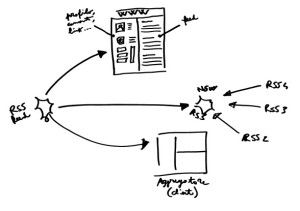Last Updated on July 20, 2020 by Carolyn McRae
We’ve all heard it before. Blogging is a powerful way to maintain your online brand and increase client engagement. You can write timely content in your tone, about any topic you choose.
But blogging isn’t a field of dreams in which “if you build it, they will come.”
No. To get the most out of each post, you need to have a smart system for sharing it.

I have tried various approaches when it comes to keeping my audience aware of new posts on my blog. I’ve had an HTML-coded newsletter made by web developers, used social media, direct email, and even printed out my blog posts for presentation attendees. But what works best when it comes to engaging clients and attracting prospects with the stuff you’re writing?
Here’s what I’ve learned so far…
Social Sharing Alone Isn’t Enough
Social media is a great way to engage your followers (and the public) with your content. Whether it’s Facebook, Twitter, Linkedin, or even Pinterest, you can leverage your client’s audience when they “Like”, “ReTweet”, or “RePin” the post.
I have had people start conversations with me on social media as the result of posts that I have made. Not only can I emphasize the content of the post, but I can start to build relationships with people this way as well.
But while there is a lot of leverage in any potential audience, you will be fighting against pictures of grandbabies, vacations and birthday parties. I’ve even found on my company Facebook page (that has ~650 likes) that I’m fighting against Facebook algorithms to get my content shown to anything over 10% of my followers.
Automatic Alerts Save Time, But…
For those of you who blog frequently (at least once per week), an automatic e-newsletter can be a great time-saving way to notify your audience and summarize your latest content. If you have RSS capability attached to your blog, you can auto-populate these emails and set it up to send new posts out automatically via free services such as MailChimp. Using the titles and descriptions that have been used for these posts, the e-newsletter can be made, formatted and sent to a subscription list with no maintenance from you.
On the flip side, some advisors are incredibly inconsistent when it comes to the frequency of blogging. Some do it multiple times a week, others a couple of times a year. For those blogging less than twice a month, an automatic e-newsletter doesn’t really hold much benefit. You’ll remind your audience that you’re not updating your site with much material, and they’ll quickly hit delete when they see your emails.
I used one of these automatic e-newsletters when I started my firm. I had a designer code the newsletter in HTML and brand it so it matched my company colors. Over time, I continued to add subscribers and content, but found that, as my email design was the same every time, my “click through” rates were starting to drop. While many advisors use the same template every month, I wanted something that was even more successful.
So I went away and researched what “viral marketers” were doing.
Custom Emails Require Time, But…
Many marketers send out personalized e-newsletters that keep me hanging on every word. One of those is by Derek Halpern of Social Triggers. He writes conversational content, shoots great videos, and challenges the way I think about marketing. So I chose to copy his style.
I used to publish blog posts every couple of days and it would be sent in a branded e-newsletter every week. Now I post every 10-14 days and let people know about the content in personal, customized emails. This is through the same newsletter software, but now I spend extra time creating my content and writing stories in my emails. My thinking is that if people can relate with these emails, they will read them and click the content more often than not. It does take more time to put these together, but I treat it as though I am just writing another email to keep in touch with clients. Though custom emails may seem like “too much work”, this, by far, has given me the most success of people seeing and reading my material.
What about you?
How do you keep your readers in touch with what you’re blogging about? How successful has it been for you? What tools are you using? Would love to hear about your experiences.

Photo credit: francescopozzi, Flickr